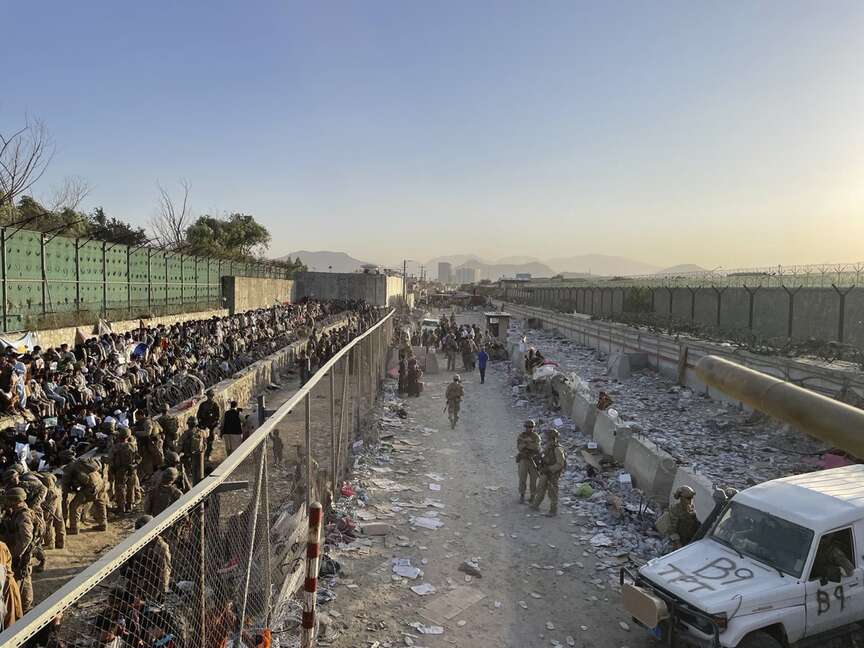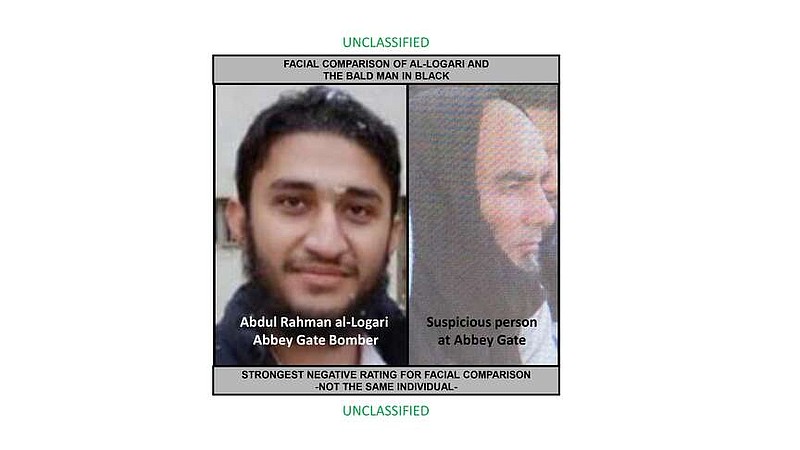WASHINGTON -- The suicide bombing at the Kabul airport that killed U.S. troops and Afghans in August 2021 was not preventable, and the "bald man in black" spotted by U.S. service members the morning of the attack was not the bomber, according to a new review by U.S. Central Command.
The findings, released Monday, rebut assertions by some service members who believed they had a chance to take out the would-be bomber but did not get approval. And, for the first time, the U.S. military is confirming that the bomber was Abdul Rahman al-Logari, an Islamic State militant who had been in an Afghan prison but was released by the Taliban as the group took control of the country that summer.
The Abbey Gate bombing during the final chaotic days of the Afghanistan withdrawal killed 13 U.S. service members and 170 Afghans and wounded scores more. It triggered widespread debate and congressional criticism.
The bombing was a searing experience for the military after 20 years of war in Afghanistan. Thirteen flag-draped coffins were flown to Dover Air Force Base in Delaware, and funerals were held across the country for the service members, most of them younger than 25.
The narrative of missed opportunities to avert tragedy has gained momentum over the past year among conservatives and has contributed to broader Republican criticisms of the Biden administration's troop withdrawal and evacuation from Kabul.
While the United States was able to get more than 130,000 civilians out of the country during the panic after the Taliban took control of the government, there were horrifying images of desperate Afghans clinging to military aircraft as they lifted off.
Under mounting political pressure to address disparities from an earlier review and the accounts of the Marines at the gate -- which also included reports that the Islamic State group had conducted a test run of the bombing -- a team of Army and Marine Corps officers interviewed more than 50 people who were not interviewed the first time around.
At the airport, investigators said, the bomber detonated a 20-pound explosive, probably carried in a backpack or vest, spraying 5mm ball bearings in a tremendous blast that was captured in grainy video images shown to Pentagon reporters.
On the day of the bombing, Marines at the gate were told to be on the lookout for a man with groomed hair, wearing loose clothes and carrying a black bag of explosives. The review team determined, after additional interviews and assessing security camera footage and other photographs of the chaotic scene, that the description was not specific enough to meaningfully narrow the search.
But Marines at the gate came forward later to say that at 7 a.m., they saw an individual matching the suicide bomber's description. The Marines said the man had engaged in suspicious behavior and that they had sent urgent warnings to leaders asking for permission to shoot. Twice their request was denied, they said.
The review team concluded that the Marines had conflated the intelligence reports with an earlier spotting of a man wearing beige clothes and carrying a black bag. The team also reviewed a photo taken of the suspect from one of the sniper team's cameras.
The man in question did not actually match the description, the review team concluded. He was bald, wore black clothes and was not carrying a black bag. Moreover, photographs taken of al-Logari when he was in U.S. custody did not match the photographs of the suspect, even after facial recognition software was used.
Team members said the review also could not completely rule out claims that militants did a test run of the bombing several days earlier. But after reviewing photos and other intelligence, the team concluded it was unlikely that three men seen carrying a large bag -- which troops deemed suspicious -- were doing a trial run.
More broadly, the team said the review brought some new details to light, including more discussion about the possible bombing test run. But they said overall it confirmed the findings of U.S. Central Command's initial investigation into the bombing: that it was not preventable and that reports of threats before the bombing were too vague.
Members of the team said the Islamic State group put out the bomber's name on social media, but U.S. intelligence was later able to independently confirm that report.
U.S. Central Command's initial investigation concluded in November 2021 that given the worsening security situation at the airport's Abbey Gate as Afghans became increasingly desperate to flee, the attack was not preventable at the tactical level without degrading the mission to maximize the number of evacuees."
Information for this article was contributed by Lolita C. Baldor and Farnoush Amiri of The Associated Press and Eric Schmitt of The New York Times.
 A digital display of a sniper team member's camera on August 26, 2021, shows the "bald man in black" that some service members believed was the would-be bomber. A review released Monday, April 15, 2024, says the suicide bombing at the Kabul airport that killed U.S. troops and Afghans in August 2021 was not preventable, and the "bald man in black" spotted by U.S. service members the morning of the attack was not the bomber. (U.S. Central Command via AP)
A digital display of a sniper team member's camera on August 26, 2021, shows the "bald man in black" that some service members believed was the would-be bomber. A review released Monday, April 15, 2024, says the suicide bombing at the Kabul airport that killed U.S. troops and Afghans in August 2021 was not preventable, and the "bald man in black" spotted by U.S. service members the morning of the attack was not the bomber. (U.S. Central Command via AP) The bombing area at Abbey Gate is pictured August 26, 2021, in Kabul, Afghanistan, before the blast. A review released Monday, April 15, 2024, says the suicide bombing at the Kabul airport that killed U.S. troops and Afghans in August 2021 was not preventable, and the "bald man in black" spotted by U.S. service members the morning of the attack was not the bomber. (U.S. Central Command via AP)
The bombing area at Abbey Gate is pictured August 26, 2021, in Kabul, Afghanistan, before the blast. A review released Monday, April 15, 2024, says the suicide bombing at the Kabul airport that killed U.S. troops and Afghans in August 2021 was not preventable, and the "bald man in black" spotted by U.S. service members the morning of the attack was not the bomber. (U.S. Central Command via AP)
